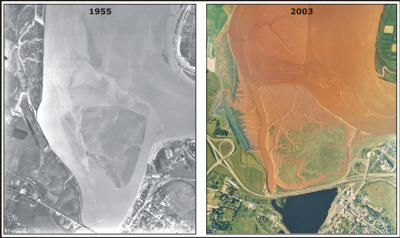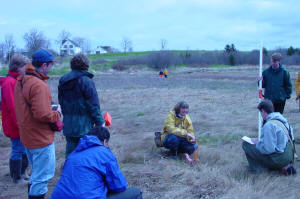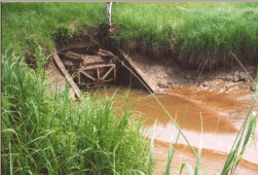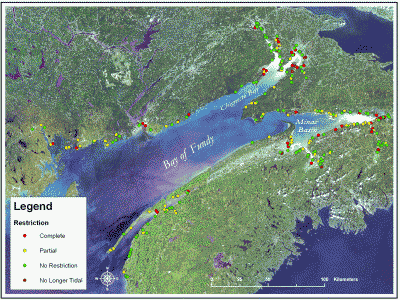Ecomorphodynamics of Intertidal Ecosystems in Modified Estuaries
'Ecomorphodynamics'
refers to the study of the interaction and adjustment of topography, vegetation,
fluid and hydrodynamic processes, morphologies and sequence of change dynamics
involving the movement of sediment. These feedbacks are clearly evident within
the vast intertidal ecosystems located in macrotidal systems such as the Bay of
Fundy. Salt marshes and mudflats represent delicately balanced systems between
hydrodynamic forces and ecological, sedimentological and morphological
responses.
A key to survival for many of these
coastal ecosystems in face of climate change is to maintain this delicate
balance. Changes in marsh or mudflat surface elevation within the tidal frame
or changes in edge morphology will in turn induce changes in tidal prism,
hydrodynamic forces, vegetation community structure, rates of sedimentation and
dissipation (marsh platform) or amplification (cliff) of wave energy. The rate
of these changes can be significantly influenced by human development such as
the construction of tidal barriers or installation of shore protection.
The purpose of
this research program is to examine the spatial and temporal changes in
intertidal habitats
in macrotidal environments such as the Bay of Fundy and isolate the
relative significance of factors controlling these changes. It involves the
integration of meso-scale (decadal/basin wide) quantification of geomorphic
changes in the intertidal zone using ArcGIS and high resolution digital
elevation models with micro-scale (seasonal to tidal
cycle/marsh level) investigations of sedimentary processes within salt marshes
and mudflats of this region. 
These research projects will help to develop an understanding of the mechanisms controlling the stability and resilience of mudflat and salt marsh systems in the Bay of Fundy, identifying geomorphic triggers between erosive and progradational states and overall response to the effects of climate change.
Development of marsh/mudfalt system downstream of the Windsor causeway (van Proosdij & Townsend, 2006)
Of particular interest is the response or resiliency of intertidal ecosystems to anthropogenic activities such as dyke and causeway construction or shore protection and the potential responses of the ecosystem to removing these tidal barrier structures or modifying the tidal energy within the area (e.g. tidal power).
Collaborators:
Nova Scotia Department of Agriculture, Resource Stewardship Division, Land Protection Section
Department of Fisheries and Oceans, Bedford Institute of Oceanography
Nova Scotia Department of Transportation and Infrastructure Renewal
Acadia Center for Estuarine Research
Past & Present Students:
Greg Baker, Sarah Townsend, Jillian Bambrick, Amanda Pike, Erinn O'Toole, Peter Horne, Kelly Mazerolle, Casey O'Laughlin
Funding Sources:
Saint Mary's University
Bay of Fundy Ecosystem Partnership (BoFEP) with the Gulf of Maine Council
Selected Publications:
van Proosdij, D.; Milligan, T.; Budgen, G. and C. Butler. 2009. A Tale of Two Estuaries: Differential Morphodynamic Response of the Intertidal Zone to Causeway Construction. Journal of Coastal Research SI 56:772-776. ISBN 0749-0258.
van Proosdij, D. and G. Baker. 2008. Intertidal Morphodynamics of the Avon River Estuary. Final report prepared for the Nova Scotia Department of Transportation 186 pp.
van Proosdij, D; Bambrick, J. and G. Baker. 2007. Spatial and Temporal Variations in the Intertidal Geomorphology of the Avon River Estuary. Final report prepared for the Nova Scotia Department of Transportation 82 pp.
van Proosdij, D. and S., Townsend. 2006. Spatial and Temporal Patterns of Salt Marsh Colonization Following Causeway Construction in the Bay of Fundy. Journal of Coastal Research, SI 39 (Proceedings of the 8th International Coastal Symposium):1858-1862, Itajai, SC - Brazil, 2004 ISSN 0749-0208
Daborn, G.R.; Brylinsky, M. and D. van Proosdij. 2003. Ecological Studies of the Windsor Causeway and Pesaquid Lake, 2002. Final report prepared for Nova Scotia Department of Transportation Contract # 02-00026. Acadia Centre for Estuarine Research Publication No. 69. 111 pp.
Hydrodynamics and Sedimentary Processes of Intertidal Ecosystems
The purpose of this research is to examine the temporal and spatial variations in hydrodynamics and sedimentary processes of intertidal ecosystems with a particular focus on muddy macrotidal systems. The new (2008) Intertidal Coastal Sediment Transport Research Unit (In_CoaST) at Saint Mary's University will play an integral role for this research. The research will examine the interactions and feedbacks that occur between topography, biota (e.g. vegetation and invertebrates), hydrodynamic (e.g. waves and currents) and sedimentary (e.g. suspended sediment concentration, deposition, erosion) processes and the resultant adjustment of intertidal morphology at a range of spatial and temporal scales. Of particular interest is the response of intertidal environments to changes in forcing functions (e.g. wind, waves, tides, currents, sediment, vegetation, topography) and how anthropogenic activities impact this response.
Data collection at low and mid spring tide on the Avon River, Bay of Fundy (photo by A. Silver,2008)
Additional research is being undertaken to examine the role of ice and winter meteorological conditions on sediment transport processes and dispersal of vegetation.
Ice blocks laden with sediment on Windsor marsh, Feb 2007
Collaborators:
Mount Alison Coastal Wetlands Institute
Department of Geography, University of Guelph
Department of Fisheries and Oceans, Bedford Institute of Oceanography
Natural Sciences and Engineering Research Council (NSERC)
Past & Present Students:
Casey O'Laughlin, Amanda Pike, Amber Silver
Funding Sources:
Selected Publications:
O'Laughlin, C. and D. van Proosdij. 2009. Comparison of Vertical and Temporal Variations in Hydrodynamics on Macro-tidal Mudflat and Salt Marsh Surfaces in the Bay of Fundy. Proceedings of the 8th Bay of Fundy Ecosystem Partnership Science Workshop, Wolfville, NS. 10 pp.
Silver, A. and D. van Proosdij. 2009. The Influence of Vegetation on Sedimentary Processes in a Macro-tidal Salt Marsh. Proceedings of the 8th Bay of Fundy Ecosystem Partnership Science Workshop, Wolfville, NS. 10 pp.
van Proosdij, D.; Davidson-Arnott, R.G.D. and J. Ollerhead, J. 2006. Controls on the spatial patterns of sediment deposition across a macro tidal salt marsh over single tidal cycles. Estuarine, Coastal and Shelf Science 69(1-2):64-86.
van Proosdij, D.; Ollerhead, J. and R.G.D. Davidson-Arnott. 2006. Seasonal and Annual Variations in the Sediment Mass Balance of a Macro-tidal Salt Marsh. Marine Geology 225: 103-127.
Salt Marsh Restoration
For centuries, human activities have reduced the amount of salt marsh and free-flowing tidal river habitats in many areas around the world. Conservative estimates for the Bay of Fundy put the loss of salt marsh habitat between 80 to 85% mostly associated with dyking and conversion to agricultural land. Although these activities are of historical and social significance, it is now recognized that the significant loss of habitat, species and primary productivity that has resulted from the construction of dikes, modern tidal barriers (causeways) and coastal development has had significant ecological implications, which are preventable and repairable if tidal hydrology is appropriately restored.
One year post dyke breaching at Walton Creek restoration site, June 2007 (photo by CBWES Inc.)
Salt marsh ecosystem function may be restored passively when a dike is breached during a storm with little to no human interference or through active means by planned removal or modification of a barrier to restore tidal flow. Examination of passive restoration sites can provide long term records about vegetation and geomorphic recovery however provide limited information about driving and/or limiting variables within the first few years after the breach event that may influence the ultimate recovery of the system. In addition, the European experience has shown that salt marsh re-establishment is not inevitable at all sites following a breach. Properly monitored restoration projects can sometimes provide additional information on constraints that may have caused a restoration project to proceed along successional pathways not initially anticipated.
 My students and I work closely
with CB Wetlands and Environmental Specialists Inc
(CBWES) to examine the vegetative,
sedimentary, nekton and hydrologic conditions pre-restoration and the initial
five years post-restoration at salt marsh sites across the province both on the
Fundy and Atlantic coasts. Additional areas of research include tidal
channel hydraulics and wetland design and biogeographical processes (e.g.
vegetative community interactions, dispersal mechanisms) within these systems. Opportunities for
NSERC industrial internships with CBWES are available at the undergraduate and graduate level.
My students and I work closely
with CB Wetlands and Environmental Specialists Inc
(CBWES) to examine the vegetative,
sedimentary, nekton and hydrologic conditions pre-restoration and the initial
five years post-restoration at salt marsh sites across the province both on the
Fundy and Atlantic coasts. Additional areas of research include tidal
channel hydraulics and wetland design and biogeographical processes (e.g.
vegetative community interactions, dispersal mechanisms) within these systems. Opportunities for
NSERC industrial internships with CBWES are available at the undergraduate and graduate level.
These data will contribute to the development of long term data sets of pre-restoration, post-restoration, and reference marsh conditions to determine if a marsh is proceeding as expected and to help with models that are aimed at predicting the response of marshes to tidal restoration at the upper end of the tidal spectrum. In addition, these results can provide insight into the ecological interrelationships between biotic and abiotic variables and contribute to the development of a set of reference marsh conditions for future restoration projects in the Bay of Fundy and Atlantic coastal areas.
Collaborators:
CB Wetlands and Environmental Specialists
Dr. Jeremy Lundholm, Department of Biology, Saint Mary's University
Nova Scotia Department of Agriculture, Resource Stewardship Division, Land Protection Section
Nova Scotia Department of Transportation and Infrastructure Renewal
Past & Present Students:
Greg Baker, Nancy Chiason, Amber Silver
Funding Sources:
Saint Mary's University
Selected Publications:

Tidal Barrier GIS Database Development
 Over
the last century, the majority of rivers entering into the Bay of Fundy have
been highly modified through the construction of tidal barriers. The
construction of these barriers resulted in either partial or complete
obstruction to tidal flow in many areas around the Bay. Tidal barriers
effectively decrease turbulent energy in the tidal system causing sediments and
other particles to drop from suspension and accumulate as deposits of mud, sand
and silt. In other areas, localized erosion is initiated either directly
upstream or downstream of a partially restrictive barrier. Ecosystems
inhabiting this zone, such as mudflats and salt marshes, are some of the first
environments to feel the effects of coastal modification. These changes have
cascading impacts on intertidal ecosystems, some negative and others positive.
Overall however, the cumulative impacts of tidal barriers on intertidal
ecosystems of the Bay of Fundy are unknown. This is of particular concern with
increasing interest in removing or modifying tidal barriers in an effort to
'return the tides'. Without a solid baseline of past and present 'states' of
these systems, assessing or predicting the success of restoration activities is
difficult.
Over
the last century, the majority of rivers entering into the Bay of Fundy have
been highly modified through the construction of tidal barriers. The
construction of these barriers resulted in either partial or complete
obstruction to tidal flow in many areas around the Bay. Tidal barriers
effectively decrease turbulent energy in the tidal system causing sediments and
other particles to drop from suspension and accumulate as deposits of mud, sand
and silt. In other areas, localized erosion is initiated either directly
upstream or downstream of a partially restrictive barrier. Ecosystems
inhabiting this zone, such as mudflats and salt marshes, are some of the first
environments to feel the effects of coastal modification. These changes have
cascading impacts on intertidal ecosystems, some negative and others positive.
Overall however, the cumulative impacts of tidal barriers on intertidal
ecosystems of the Bay of Fundy are unknown. This is of particular concern with
increasing interest in removing or modifying tidal barriers in an effort to
'return the tides'. Without a solid baseline of past and present 'states' of
these systems, assessing or predicting the success of restoration activities is
difficult.
Coastal systems such as mudflats and marshes are not static features, they undergo cycles of progradation and retreat that are well documented around the world. These cycles have been linked to changes in sea level and in the tidal prism due to human activities such as tidal barrier construction or dredging, changes in wind/wave climate, sediment supply, cliff morphology, intertidal sedimentation and changes in the location of the major tidal channel. One of the most effective ways of documenting these changes is through the analysis of rectified aerial photographs within a GIS system. This is the preliminary stage that is required before any true questions regarding the 'why' of these changes are addressed.
 The
purpose of this collaborative research project was to integrate the Bay of Fundy
Tidal Barrier Audits conducted by the Ecology Action Center (EAC) and
Conservation Council of New Brunswick (CCNB) into a comprehensive digital
spatial database being developed in a concurrent project with Environment
Canada. Together, they will be used as a baseline to assess the cumulative
impacts of tidal barriers in the Upper Bay of Fundy and serve as a platform for
future research. This portion of the project will focus on data that is of
particular interest for salt marsh restoration initiatives and serve as a
valuable management tool. Baseline data currently integrated into the database
include: 1:10,000 planimetric (NS,NB), property management units and type
classification (NS), watershed boundaries (NS,NB), digital elevation model (NS,
NB), Landsat 7 ETM - 30 m resolution imagery as well as digital orthophographs
(4m resolution) for New Brunswick (NB) and orthorectified aerial photographs (1
m resolution) for portions of Nova Scotia (NS), particularly the Southern Bight
of the Minas Basin. The full GIS is available to researchers and government
agencies as long as the potential users have secured appropriate licensing
permission from the data providers if those data are not freely available. The
geographical coordinates of tidal barriers inventoried for both NS (216 sites)
and NB (91 sites) have been integrated into the GIS. Full fact sheets and
summaries of the audits were prepared in conjunction with the EAC for NS and are
available on-line as downloadable PDFs. Basic attribute information and maps
for NB barriers will also be available within the GIS framework however
completion of complete fact sheets available to the public is not feasible
within the time frame of the project at this time. LINK
to TIDAL BARRIER DATABASE via B0FEP website.
The
purpose of this collaborative research project was to integrate the Bay of Fundy
Tidal Barrier Audits conducted by the Ecology Action Center (EAC) and
Conservation Council of New Brunswick (CCNB) into a comprehensive digital
spatial database being developed in a concurrent project with Environment
Canada. Together, they will be used as a baseline to assess the cumulative
impacts of tidal barriers in the Upper Bay of Fundy and serve as a platform for
future research. This portion of the project will focus on data that is of
particular interest for salt marsh restoration initiatives and serve as a
valuable management tool. Baseline data currently integrated into the database
include: 1:10,000 planimetric (NS,NB), property management units and type
classification (NS), watershed boundaries (NS,NB), digital elevation model (NS,
NB), Landsat 7 ETM - 30 m resolution imagery as well as digital orthophographs
(4m resolution) for New Brunswick (NB) and orthorectified aerial photographs (1
m resolution) for portions of Nova Scotia (NS), particularly the Southern Bight
of the Minas Basin. The full GIS is available to researchers and government
agencies as long as the potential users have secured appropriate licensing
permission from the data providers if those data are not freely available. The
geographical coordinates of tidal barriers inventoried for both NS (216 sites)
and NB (91 sites) have been integrated into the GIS. Full fact sheets and
summaries of the audits were prepared in conjunction with the EAC for NS and are
available on-line as downloadable PDFs. Basic attribute information and maps
for NB barriers will also be available within the GIS framework however
completion of complete fact sheets available to the public is not feasible
within the time frame of the project at this time. LINK
to TIDAL BARRIER DATABASE via B0FEP website.
Collaborators:
Funding Sources: